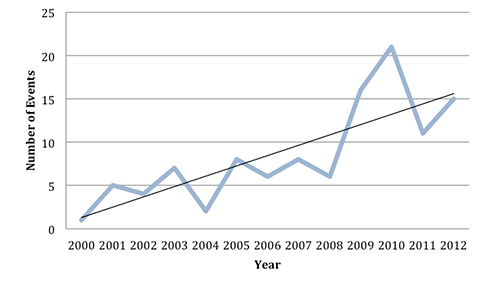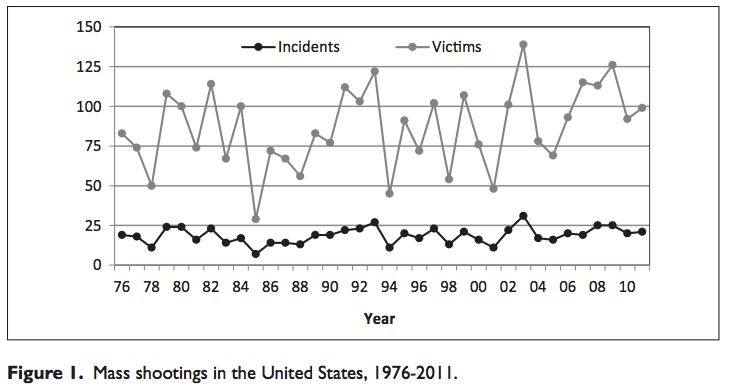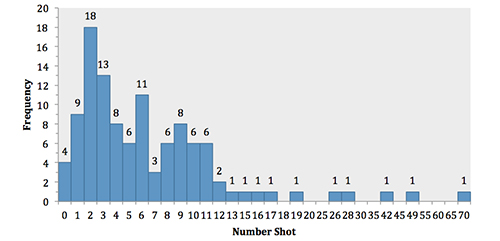The FBI Law Enforcement Bulletin has released a new report focusing on “Active Shooter Events from 200o to 2012.” Is an “Active Shooting Event” the same thing as a mass shooting? No. As I discuss in The Shooting Cycle, the number of mass shootings, defined by four or more deaths in as ingle incident, has remained at roughly the same level for the past few decades.
In contrast, an “Active Shooting Event” involves, one or more death in a single incident where the shooter intends to kill multiple people.
The federal government defines an active shooter as “an individual actively engaged in killing or attempting to kill people in a confined and populated area, typically through the use of firearms.”[3] For this study ASEs were located via a systematic search strategy.[4] Public records were searched using a variety of search terms to locate news stories from 2000 to 2012 involving potential ASEs in the United States. Incidents identified from these searches then were evaluated to see if they met the following criteria: The event had to involve one or more persons engaged in killing or attempting to kill multiple people in an area occupied by multiple unrelated individuals—at least one of the victims must be unrelated to the shooter.
Part of the report tracks the number of active shooting events over the last 12 years, and shows the number has increased threefold over the last 12 years.
Figure 1 presents the frequency of ASEs by year. The dotted trendline shows a definite increase over the past 12 years. In fact, the number of events drastically increased following 2008. The rate at which these events occurred went from approximately 1 every other month between 2000 and 2008 (5 per year) to more than 1 per month between 2009 and 2012 (almost 16 per year). The authors’ tracking also indicates that this increased rate has continued into 2013—more specifically, there were 15 events. While it is possible that this increase is an artifact of the search strategy (perhaps, archiving of the news reports has improved in recent years), the authors believe that the observed rise represents a real increase in the number of events in recent years. Figure 2 shows the number of people shot and the number of people killed for each year. Here again the trend line shows a definite increase. The authors’ tracking indicated that there were 72 people shot and 39 killed in 2013.
I’ve already seen several news outlets report this number to prove that mass shootings are on the rise. NPR is more nuanced, accurately labeling them “mass murders,” which are different from mass shootings.
I will quote at length from my new article, The Shooting Cycle, which offers the most recent numbers confirming that there is no increased trend in mass shootings, defined as four or more deaths in a single incident.
“Shooting” is not considered a term of art among criminologists. The closest approximation is the “mass murder.” The government does not keep statistics focusing specifically on of “mass shootings.” Politifact observed that despite reading through the FBI’s Uniform Crime Report[1] and the Bureau of Justice Statistics’ National Crime Victimization Study,[2] they could not “find any published statistics on mass shootings.”[3] The FBI defines a “mass murder,” as distinguished from a “serial murder,” as “a number of murders (four or more) occurring during the same incident, with no distinctive time period between the murders.”[4] Two of the leading scholars on mass murder, Professors James Alan Fox and Jack Levin, define mass murder more precisely, as the “slaughter of four or more victims by one or a few assailants within a single event, lasting but a few minutes or as long as several hours.”[5] As Fox and Levin noted, in “striking contrast to the expanding scholarly interest in serial homicide, mass killings—the slaughter of victims during a single act or a short-lived crime spree—have received relatively little consideration.”[6] We will rely on the definition of mass murder as defined by Professors Fox and Levin, and use the term “mass shooting” interchangeably.
Contrary to popular perceptions, mass shootings are rare, constituting a tiny share of homicides. The magazine Mother Jones offers a detailed, comprehensive list of mass shootings between 1982 and the present, counting 67 mass shootings.[7] The New Republic, building on the Mother Jones report, counted 70 mass shootings between 1982 and 2012.[8] Though each loss of life is tragic, these deaths constitute a very, very small percentage of gun homicides. In 2005, 0.12% of homicides involved four victims (the threshold for a mass shooting).[9] To put that in perspective, roughly 1 out of every 1,000 gun homicides results from a mass shooting. [10] If you decrease the threshold to three victims, the rate rises to 0.60%.[11] Another study revealed that between 1976 and 2005, “less than 1/5 of 1% (0.18%) of all murders in the United States involved four or more victims.”[12]
Even among mass murders, the “indiscriminate slaughter of strangers”—what is commonly portrayed as a mass shooting—“is the exception to the rule.”[13] From 1976-1995, 39.4% of mass murders were “familicides,” where the victim was related to the shooter, and 38.2% were people the shooter knew.[14] Only 21.4% of the victims of the 483 mass murders during this period were strangers. In other words, even among the small number of mass shootings, an even smaller share are indiscriminate killings in public places, such as schools or movie theaters. As a total percentage of unfortunate bloodshed, mass shootings are a small, small sliver that nonetheless captures a huge percentage of the public fascination.
Further, contrary to what the zeitgeist may suggest, mass shootings are not on the rise. Professor James Alan Fox has found that “[d]espite the huge media coverage devoted to them, crime statistics show that there is no upward trend in mass killings.”[15] Fox and DeLateur offer an alternate analysis based on “the FBI’s Supplementary Homicide Reporting (SHR) program” from 1976 to 2011 that reflects “all 672 mass shootings with at least four fatalities reported to local law enforcement authorities.”[16]
Fox and DeLateur observe that over the past few decades, “there have been, on average, nearly 20 mass shootings a year in the United States,” most of which were nowhere near “as deadly” as Newtown or Aurora. The authors conclude, “Without minimizing the pain and suffering of the hundreds of those who have been victimized in recent attacks, the facts clearly say that there has been no increase in mass shootings and certainly no epidemic.” Instead, the only thing that is clear about the data is the “largely random variability in the annual counts.” Fox stressed, “the risk of this type of crime is significantly less than a wide array of other catastrophes that we confront every day.”
According to another analysis by Politifact, which considered these events over the past three decades, there is no clear trend in the number of annual mass shootings: 1976-1980 (20.6 incidents annually), 1981-1985 (16.8), 1986-1990 (18.2), 1991-1995 (23.0), 1996-2000 (20.0), 2001-2005 (21.0), 2006-2009 (25.5).[17] Politifact rated as “half true” a statement that recent shootings in Arizona reflect a “disturbing trend.” Rather than a “disturbing trend,” Politifact observed that the number of mass shootings in 2007 (23), 2008 (29), and 2009 (27) barely changed; it was “statistical noise.”[18] This reflects Professors Fox and DeLateur’s findings.
Noted criminologist Gary Kleck observes that “It would be misleading to suggest that there was some long-term upward trend in mass shootings since 1976.” He added, “The exact number are highly unstable, but ignoring small, year-to-year fluctuations, there was no trend one way or the other from 1976 to 2009. Further, if these figures were computed on a per-capita basis, taking into account population increases, the long-term trend in the rate would be downward.”[19] These numbers even hold true throughout most of the twentieth century, as “mass murder”—slightly different from mass shootings—“was nearly as common during the 1920s and 30s as it has been since the mid-1960s.”[20] Further, as Professor Mark Melter points out, “the mass shooting rate has remained relatively stable over the past forty years” as compared with “the rates of homicide and serious violent crime have dropped significantly during the same period.”[21] The rate of mass shootings has remained nearly constant, notwithstanding numerous other changes in our increasingly-safer society.
Specifically, mass shootings on college campuses are also not as common as popular culture would suggest. Professor Fox observed that, “Overall in this country, there is an average of 10 to 20 murders across campuses in any given year.”[22] As noted, single homicides are much, much less common than mass murders. Fox continues, “Compare that to over 1,000 suicides and about 1,500 deaths from binge drinking and drug overdoses annually.”[23] A 2011 study looking into the causes of death of college students, conducted across 157 four-year institutions, comprising 1,361,304 students, found that the annualized mortality rate per 100,000 students was, ranked from highest to lowest, (1) suicide 6.18, (2) alcohol related traffic deaths 3.37, (3) unknown cause 3.00, (4) cancer (1.94), (5) alcohol related non-traffic injury (1.49), and finally (6) homicide (0.53).[24] Homicide—not from mass shootings—trails far, far behind on causes of deaths. For every 200,000 college students, roughly two die per year due to homicide (to say nothing of a mass shooting), while thirteen die from suicide and 7 die from drunk driving. Similar trends hold true for safety in K-12 schools, which garnered a significant amount of attention in the wake of the tragedies of Columbine and Newtown. According to a report by the Center for Disease Control, the probability of a child “dying in school in any given year from homicide or suicide was less than one in 1 million between 1992 and 1994 and slightly greater than one in 2 million between 1994 and 1999.”[25]
A study performed by USA Today quantified the number of mass killings, rather than mass shootings, which include incidents where four or more people are killed by any means, including gun shot, in addition to smoke inhalation, stabbing, strangulation/suffocation, blunt force, and drowning.[26] Even with this expanded metric, the study concluded that “the number of mass killings has not increased in recent years.”[27] A report from the Advanced Law Enforcement Rapid Response Training (ALERRT) Center at Texas State University found an increase from 2000 to 2013 in the number of “active shootings in public settings where the primary motive appeared to be mass murder and at least one of the victims was unrelated to the suspect.”[28] But these active shooter situations are not mass shootings, as it includes incidents with a single, rather than four, deaths.
These statistics should dispel many of the common perceptions about the prevalence and frequency of deaths by mass shootings.
[1] FBI Releases Preliminary Semiannual Crime Statistics for 2010, Federal Bureau of Investigation (Dec. 20, 2010), http://www.fbi.gov/news/pressrel/press-releases/prelimsemiucr_122010
[2] Jennifer Truman & Michael Rand, Bureau of Justice Statistics Bulletin: Criminal Victimization, 2009 (Oct. 2010), available at http://bjs.ojp.usdoj.gov/content/pub/pdf/cv09.pdf
[3]“This Week” report says hundreds have died in multiple-victim shootings, Polifact (Jan. 11, 2011), http://www.politifact.com/truth-o-meter/statements/2011/jan/11/pierre-thomas/week-report-says-hundreds-have-died-multiple-victi/
[4]Federal Bureau of Investigation National Center for the Analysis of Violent Crime, Serial Murder: Multi-Disciplinary Perspectives for Investigators (2005), available at http://www.fbi.gov/stats-services/publications/serial-murder/serial-murder-1#two.
[5] James Alan Fox & Jack Levin, Multiple Homicide: Patterns of Serial and Mass Murder, 23 CRIME J. 407, 429 (1998).
[6]James Alan Fox & Jack Levin, Multiple Homicide: Patterns of Serial and Mass Murder, 23 CRIME J. 407, 430 (1998).
[7] As of December 2013, there are 67 mass shootings on the list. See Mark Follman, Gavin Aronsen, Deanna Pan & Maggie Caldwell, US Mass Shootings, 1982-2012: Data From Mother Jones’ Investigation, Mother Jones (Dec. 28, 2012) available at http://www.motherjones.com/politics/2012/12/mass-shootings-mother-jones-full-data
[8] Amy Sullivan, Mass Shootings Are on the Rise—And 2012 Has Been Deadlier Than Ever Before, New Republic (Dec. 14, 2012), http://www.newrepublic.com/blog/plank/111149/why-are-mass-shootings-the-rise#
[9] “This Week” report says hundreds have died in multiple-victim shootings, Polifact (Jan. 11, 2011), http://www.politifact.com/truth-o-meter/statements/2011/jan/11/pierre-thomas/week-report-says-hundreds-have-died-multiple-victi/
[10] “This Week” report says hundreds have died in multiple-victim shootings, Polifact (Jan. 11, 2011), http://www.politifact.com/truth-o-meter/statements/2011/jan/11/pierre-thomas/week-report-says-hundreds-have-died-multiple-victi/
[11] “This Week” report says hundreds have died in multiple-victim shootings, Polifact (Jan. 11, 2011), http://www.politifact.com/truth-o-meter/statements/2011/jan/11/pierre-thomas/week-report-says-hundreds-have-died-multiple-victi/
[12] Mark B. Melter, The Kids Are Alright; It’s the Grown-Ups Who Scare Me: A Comparative Look at Mass Shootings in the United States and Australia, 16 Gonz. J. Int’l L. 33, 35 (2012) citing Homicide Trends in the U.S., BUREAU OF JUSTICE STATISTICS (Feb. 28, 2011), http://bjs.ojp.usdoj.gov/content/homicide/tables/multivictab.cfm.
[13] James Alan Fox, Jack Levin, Multiple Homicide: Patterns of Serial and Mass Murder, 23 Crime & Just. 407, 438 (1998).
[14] James Alan Fox, Jack Levin, Multiple Homicide: Patterns of Serial and Mass Murder, 23 Crime & Just. 407, 434 (1998).
[15] Laura Smith-Spark, Are mass killings on the increase? Criminologist says no, CNN (April 3, 2012), http://www.cnn.com/2012/04/03/us/us-mass-killings/
[16] James Alan Fox & Monica J. DeLateur, Mass Shootings in America: Moving Beyond Newtown,
Homicide Studies, published online 18 December 2013 at 5 http://hsx.sagepub.com/content/early/2013/11/27/1088767913510297
[17]“This Week” report says hundreds have died in multiple-victim shootings, Polifact (Jan. 11, 2011), http://www.politifact.com/truth-o-meter/statements/2011/jan/11/pierre-thomas/week-report-says-hundreds-have-died-multiple-victi/
[18] “This Week” report says hundreds have died in multiple-victim shootings, Polifact (Jan. 11, 2011), http://www.politifact.com/truth-o-meter/statements/2011/jan/11/pierre-thomas/week-report-says-hundreds-have-died-multiple-victi/ Cf. Mark B. Melter, The Kids Are Alright; It’s the Grown-Ups Who Scare Me: A Comparative Look at Mass Shootings in the United States and Australia, 16 Gonz. J. Int’l L. 33, n. 35 (2012) (“There were on average 22.25 incidents and 108.75 victims from 2006-2009. By contrast, there were on average 18.46 incidents and 84.46 victims between 1976-2010.”).
[19]“This Week” report says hundreds have died in multiple-victim shootings, Polifact (Jan. 11, 2011), http://www.politifact.com/truth-o-meter/statements/2011/jan/11/pierre-thomas/week-report-says-hundreds-have-died-multiple-victi/
[20] Grant Duwe, A Circle of Distortion: The Social Construction of Mass Murder in the United States, 6 W. CRIMINOLOGY REV. 59, 60 (2005).
[21] Mark B. Melter, The Kids Are Alright; It’s the Grown-Ups Who Scare Me: A Comparative Look at Mass Shootings in the United States and Australia, 16 Gonz. J. Int’l L. 33, 38 (2012).
[22] Laura Smith-Spark, Are mass killings on the increase? Criminologist says no, CNN (April 3, 2012), http://www.cnn.com/2012/04/03/us/us-mass-killings/
[23]Laura Smith-Spark, Are mass killings on the increase? Criminologist says no, CNN (April 3, 2012), http://www.cnn.com/2012/04/03/us/us-mass-killings/
[24] James C. Turner, MD & Adrienne Keller, MD, Leading causes of mortality among American college students at 4-year institutions, American Public Health Association (Oct. 29, 2011), https://apha.confex.com/apha/139am/recordingredirect.cgi/id/45544
[25]Harding, David, Cybelle Fox, & Jal Mehta, Studying Rare Events Through Qualitative Case Studies: Lessons from a Study of Rampage School Shootings, 31 Sociological Methods Research 174 (2002).
[26] http://usatoday30.usatoday.com/news/nation/mass-killings/index.html#title
[27] http://www.usatoday.com/story/news/nation/2013/12/03/fbi-mass-killing-data-inaccurate/3666953/
[28] http://news.yahoo.com/spike-in-mass-shootings-creates-demand-for-different-police-approach-132625638.html “The rate at which these events occurred went from approximately one event every other month between 2000 and 2008 (5 per year) to more than one a month between 2009 and 2012 (almost 16 per year). Our tracking also indicates that this increased rate has continued into 2013.”
Update: Another part of the report focuses on the number of people shot per event:
Figure 5 depicts the number of people shot per event—the median is five. It should be noted that if the shooter is shot, the authors do not include the shooter in their counts of the number of people shot or killed. As can be seen in the figure, most of the events are clustered on the left side and do not represent mass casualty situations. However, there are a number of mass casualty situations on the right-hand side of the figure. It also is worth noting that in the five largest-casualty events (Northern Illinois University in DeKalb; Sandy Hook Elementary School; Fort Hood Army Base, Killeen, Texas; Virginia Polytechnic and State University in Blacksburg; and the Century 21 Theater) the police were on scene in about 3 minutes; yet, a substantial number of people still were shot and injured or killed.
Because it is not broken down by year, it is hard to assess the trend. By my count, there were a total of 44 incidents with between 0 and 3 deaths, 28 incidents with between 4 and 7 deaths, and 38 incidents with 8 or more deaths. No matter how you look at it, the chart is skewed to the left. The mass shooting incident with many deaths is the outlier.


